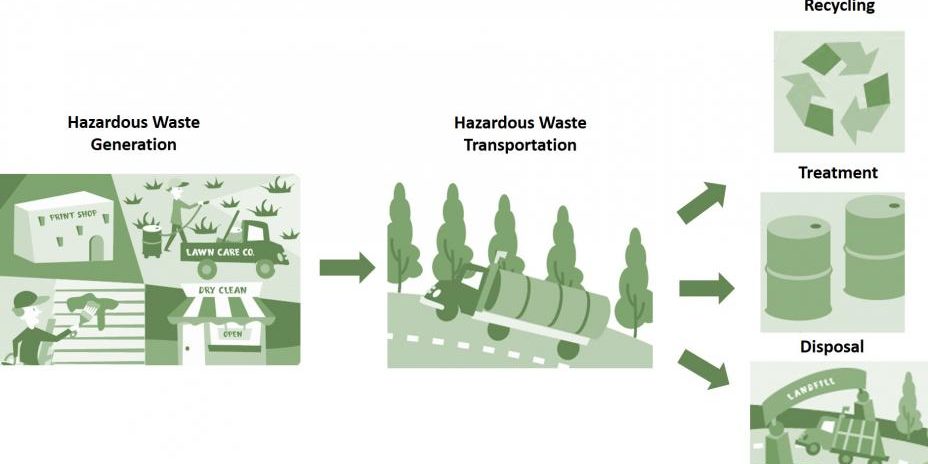Hazardous waste is a category of waste that poses substantial risks to human health and the environment due to its toxic, flammable, corrosive, or reactive properties. Proper management and disposal of hazardous waste are crucial to prevent harm and environmental contamination. Here are the key basics you should know about hazardous waste:

Definition of Hazardous Waste
Hazardous waste is waste that exhibits hazardous characteristics or contains substances that are dangerous to human health or the environment. It falls into several categories, including:
- Toxic Waste: Contains materials harmful or fatal when ingested, absorbed, or inhaled.
- Flammable Waste: Easily ignites under normal conditions.
- Corrosive Waste: Capable of corroding containers or equipment.
- Reactive Waste: Chemically unstable and can explode or release toxic gases when mixed with other substances.
Common Types of Hazardous Waste
Hazardous waste can take many forms, including:
- Industrial Waste: Generated by manufacturing processes and often includes chemicals, solvents, and heavy metals.
- Household Hazardous Waste: Generated by households and includes items like paint, pesticides, and cleaning products.
- Medical Waste: Generated by healthcare facilities and includes infectious materials and pharmaceuticals.
- Electronic Waste (E-waste): Discarded electronics containing hazardous materials like lead, mercury, and cadmium.
- Hazardous Chemicals: Any chemical that poses a hazard to human health or the environment.
Hazardous Waste Regulations
Hazardous waste is subject to stringent regulations at local, national, and international levels. Regulatory agencies, such as the Environmental Protection Agency (EPA) in the United States, set rules for the identification, transportation, treatment, and disposal of hazardous waste. These regulations are designed to protect public health and the environment.
Hazardous Waste Identification
Determining whether a waste is hazardous involves evaluating its properties and characteristics. This may include testing for toxicity, flammability, corrosivity, and reactivity. Hazardous waste generators are responsible for correctly identifying and classifying the waste they produce.

Hazardous Waste Management
Proper management of hazardous waste involves several steps:
- Waste Minimization: Reducing the generation of hazardous waste at the source.
- Storage: Safely storing hazardous waste in containers designed to prevent leaks or spills.
- Transportation: Using specialized vehicles and trained personnel to transport waste safely.
- Treatment: Treating hazardous waste to reduce its toxicity or render it non-hazardous.
- Disposal: Securely disposing of hazardous waste in specialized facilities that meet strict environmental standards.
Importance of Hazardous Waste Management
Effective hazardous waste management is crucial for several reasons:
- Environmental Protection: It prevents contamination of soil, water, and air, preserving ecosystems and biodiversity.
- Public Health: Proper management reduces the risk of exposure to toxic substances.
- Regulatory Compliance: Compliance with hazardous waste regulations is mandatory to avoid legal consequences.
- Resource Conservation: Recycling and reusing hazardous materials reduce the need for virgin resources.
Education and Awareness
Raising awareness about hazardous waste and proper disposal methods is essential. Education programs inform individuals, businesses, and communities about the risks associated with hazardous waste and the importance of responsible waste management.
Conclusion
hazardous waste poses significant risks to both human health and the environment. Understanding its properties, proper management, and adherence to regulations are essential steps in mitigating these risks and ensuring a safer and more sustainable future.
Frequently Asked Questions
What is the definition of hazardous waste?
Hazardous waste is waste that exhibits hazardous characteristics or contains substances dangerous to human health or the environment. It can be toxic, flammable, corrosive, or reactive.
What are the common types of hazardous waste?
Common types of hazardous waste include industrial waste (from manufacturing processes), household hazardous waste (from households), medical waste (from healthcare facilities), electronic waste (E-waste), and hazardous chemicals.
What are the regulations governing hazardous waste?
Hazardous waste is subject to stringent regulations at local, national, and international levels. Regulatory agencies, such as the Environmental Protection Agency (EPA), set rules for its identification, transportation, treatment, and disposal to protect public health and the environment.
How is hazardous waste identified?
Identifying hazardous waste involves evaluating its properties and characteristics, including toxicity, flammability, corrosivity, and reactivity. Hazardous waste generators are responsible for correctly identifying and classifying the waste they produce.
What are the key steps in hazardous waste management?
Proper hazardous waste management includes waste minimization, safe storage, specialized transportation, treatment to reduce toxicity, and secure disposal in specialized facilities.
Why is hazardous waste management important?
Hazardous waste management is crucial for environmental protection, public health, regulatory compliance, and resource conservation.
What role does education and awareness play in hazardous waste management?
Education and awareness programs inform individuals, businesses, and communities about the risks of hazardous waste and the importance of responsible waste management. They promote safe disposal practices and environmental stewardship.







